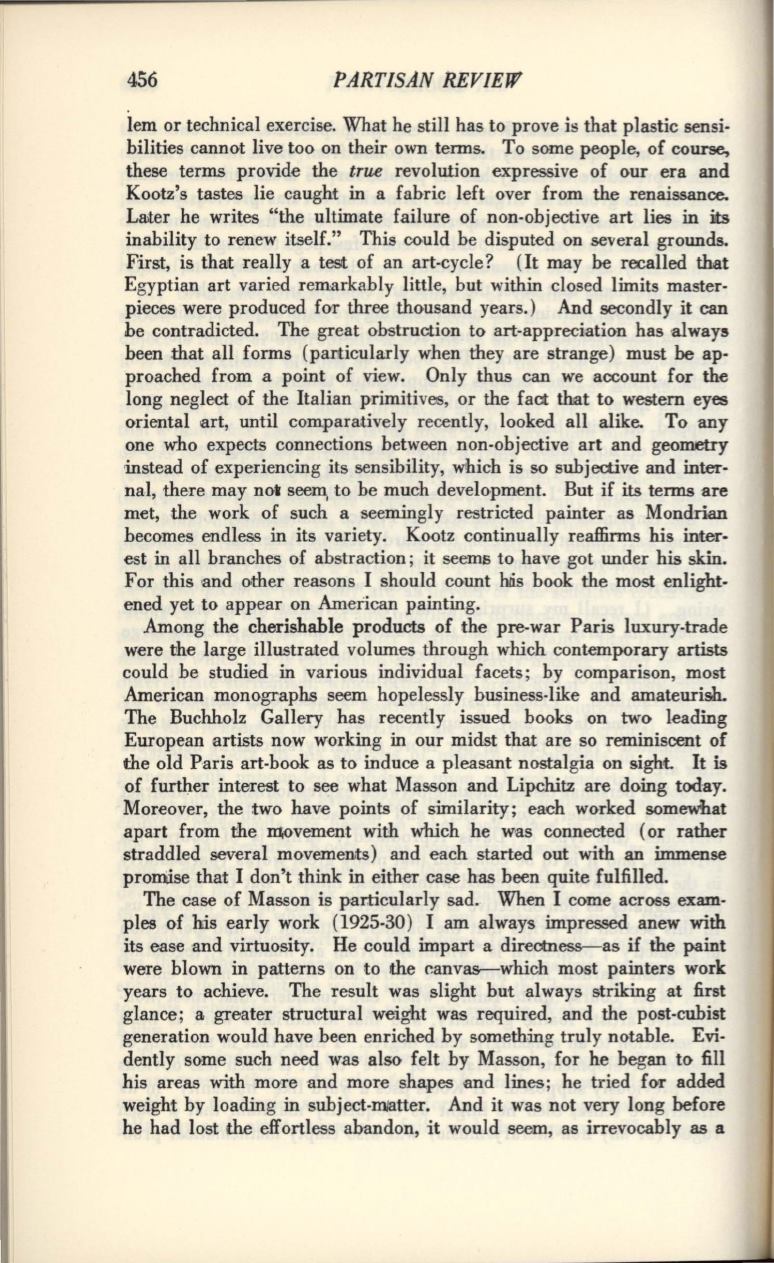
456
PARTISAN REVIEW
lem or technical exercise. What he still has to prove is that plastic sensi–
bilities cannot live too on their own terms. To some people, of course,
these terms provide the
true
revolution expressive of our era and
Kootz's tastes lie caught in a fabric left over from the renaissance.
Later he writes "the ultimate failure of non-objective art lies in its
inability to renew itself." This could be disputed on several grounds.
First, is that really a test of an art-cycle? (It may
be
recalled that
Egyptian art varied remarkably little, but within closed limits master–
pieces were produced fo'f three thousand years.) And secondly it can
he contradicted. The great obstruction to art-appreciation has ·always
been that all forms (particularly when they are strange) must
be
ap–
proached from a point of view. Only thus can we account for the
long neglect of the Italian primitives, or the fact that to western eyes
oriental art, until comparatively recently, looked all alike. To any
one who expects connections between non-objective art and geometry
·instead of experiencing its sensibility, which is so subjective and inteT–
nal, there may
no•
seem, to he much development. But if its terms are
met, the work of such a seemingly restricted painter as Mondrian
becomes endless in its variety. Kootz continually reaffirms his inter–
est in all branches of abstraction; it seems to have got under his skin.
For this •and other reasons I should count hlis book the most enlight–
ened yet to appear on American painting.
Among the cherishahle products of the pre-war Paris luxury-trade
were the large illustrated volumes through which contemporary artists
could he studied in various individual facets; by comparison, most
American monographs seem hopelessly business-like and amateurish.
The Buchholz Gallery has recently issued books on two leading
European artists now working in our midst that are so reminiscent of
the old Paris art-hook as to induce a pleasant nostalgia on sight. It
is
of
fur~er
interest to see what Masson and Lipchitz are doing today.
Moreover, the two have points of similarity; each worked somewhat
apart from the movement with which he was connected (or rather
straddled several movements) and each started out with an immense
promise that I don't think in eitheT case has been quite fulfilled.
The case of Masson is particularly sad. When I come across exam–
ples of his early work (1925-30) I am always impressed anew with
its ease and virtuosity. He could impart a directness-as
if
the paint
were blown in patterns on to the canvas--which most painters work
years to achieve. The result was slight hut always striking at first
glance; a greater structural weig'ht was required, and the post-cubist
generation would have been enriched by something truly notable. Evi–
dently some such need was also felt by Masson, for he began to fill
his areas with moTe and more shapes and lines; he tried fOT added
weight by loading in subject-m'atter. And it was not very long before
he had lost !the effortless abandon, it would seem, as irrevocably as a


